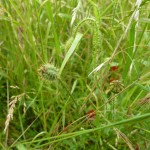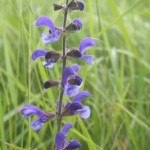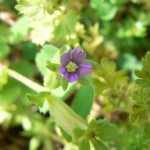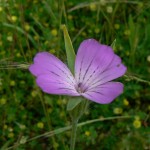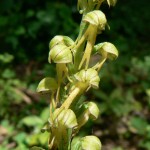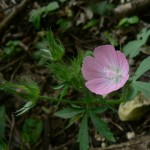The Society’s annual coach trip, on Saturday 23rd June, was to Ranscombe Farm, Plantlife’s flagship reserve in the North Downs near Rochester in Kent. The plants of the thin chalky soils above the Medway have been known to botanists for over 300 years – Meadow Clary was first described from here in 1699, as was Hairy Mallow in 1792. The reserve is a working arable farm. Two fields are particularly special for their arable plants – Kitchen Field at the southern end of the reserve and Longhoes Field, close to the entrance. Most of the group set out towards Kitchen Field, walking along tracks through the farmland. The pace slowed when a wide cultivated field margin, bright with poppies, was encountered. Amongst the Common Poppies were the smaller darker red flowers of Rough Poppy, with bristly round seed capsules. The nationally rare Narrow-fruited Cornsalad was abundant and there were also a large number of Broad-leaved Cudweed plants, of which Ranscombe holds 99% of the UK population.
At the side of the next track were specimens of Slender Thistle (or Seaside Thistle, as some of the group knew it), which were tall with small pale pink flowers. The route skirted the edge of Great Wood, with its dense, tall Sweet Chestnut coppice. Next to the wood was another wide cultivated field margin, where Meadow Clary, Corncockle, Venus’s-looking-glass, Smith’s Pepperwort and Dwarf Spurge were amongst the finds. A corner of Great Wood had about 15 spikes of Man Orchid flowers, a few Bee Orchids and a number of plants of Hairy Mallow, with its delicate pink flowers. In the open clearing beyond, a Holly Blue butterfly settled on a clump of Wild Liquorice and there were a number of Pyramidal Orchids. A picnic lunch was enjoyed at the top edge of Kitchen Field, looking down across the steeply sloping valley below. A few Ground-pine plants were found nearby. Kitchen Field had only been ploughed and planted in April. From the footpath across it, Annual Mercury, Scarlet Pimpernel, Field Pansy and other still small arable weeds were identified.
At the far side of Kitchen Field, the footpath entered Brockles Field, a former arable field which has been in set-aside for about 15 years and is developing a rich flora. Grass Vetchling and Pyramidal Orchid were amongst the plants which were seen here. The southern side of the field drops down steeply, giving good views southwards up the Medway Valley. Chris Bucke walked the long way round Brockles Field and found a large number of broomrape plants – some Common Broomrape and some an unidentified larger species. The route then dropped down through the woods of Mill Hill, where White Helleborine, Broad-leaved Helleborine, Deadly Nightshade and Columbine plants were found and a clearing had Horseshoe Vetch. Returning along the track next to the railway line at the bottom of the reserve, two Whitethroats were spotted on a fence, one with food in its bill. The final section of the walk was through Longhoes Field, where Long-headed Poppy, with a smooth, elongated seed capsule was found. Other plants seen here included Long-stalked Crane’s-bill, Corncockle and many Broad-leaved Cudweed plants. The coach then drove to the nearby Shorne Woods Country Park, where tea and cake were enjoyed.
Pictures by John Lerpiniere, David Cliffe, Laurie Haseler and Jan Haseler
| Aceras anthropophorum | Man Orchid |
| Agrimonia eupatoria | Agrimony |
| Agrostemma githago | Corncockle |
| Ajuga chamaepitys | Ground-pine |
| Alopecurus myosuroides | Black-grass |
| Alopecurus pratensis | Meadow Foxtail |
| Althea hirsuta | Rough Marsh-mallow |
| Anacamptis pyramidalis | Pyramidal Orchid |
| Anagallis arvensis | Scarlet Pimpernel |
| Anthemis cotula | Stinking Chamomile |
| Anthriscus sylvestris | Cow Parsley |
| Aphanes arvensis | Parsley-piert |
| Arctium minus | Lesser Burdock |
| Arenaria serpyllifolia | Thyme-leaved Sandwort |
| Artemisia vulgaris | Mugwort |
| Arum maculatum (fruit) | Lords-and-Ladies |
| Astragalus glycophyllos | Wild Liquorice |
| Atropa belladonna | Deadly Nightshade |
| Avena fatua | Wild-oat |
| Ballota nigra | Black Horehound |
| Bellis perennis | Daisy |
| Brachipodium pinnatum | Tor-grass |
| Brassica napus | Rape |
| Bromus hordeaceus ssp. hordeaceus | Soft-brome |
| Bryonia dioica | White Bryony |
| Campanula latifolia | Greater Bellflower |
| Capsella bursa-pastoris | Shepherd’s-purse |
| Carduus crispus | Welted Thistle |
| Carduus tenuiflorus | Slender Thistle |
| Carex sylvatica | Wood-sedge |
| Centauria scabiosa | Greater Knapweed |
| Chamerion angustifolium | Rosebay Willowherb |
| Circaea lutetiana (leaves) | Enchanter’s-nightshade |
| Cirsium arvense | Creeping Thistle |
| Cirsium palustre | Marsh Thistle |
| Clematis vitalba | Traveller’s-joy |
| Coronopus didymus | Lesser Swine-cress |
| Crataegus monogyna | Hawthorn |
| Dactylorhiza fuchsii | Common Spotted-orchid |
| Daphne laureola | Spurge-laurel |
| Echium vulgare | Viper’s-bugloss |
| Epipactis helleborine | Broad-leaved Helleborine |
| Euphorbia exigua | Dwarf Spurge |
| Filago pyramidata | Broad-leaved Cutweed |
| Fragaria vesca | Wild Strawberry |
| Galium aparine | Cleavers |
| Geranium columbinum | Long-stalked Crane’s-bill |
| Geranium dissectum | Cut-leaved Crane’s-bill |
| Geranium pusillum | Small-flowered Crane’s-bill |
| Geranium rotundifolium | Round-leaved Crane’s-bill |
| Geum urbanum | Wood Avens |
| Glechoma hederacea | Ground-ivy |
| Helianthemum nummularium | Common Rockrose |
| Hippocrepis comosa | Horseshoe Vetch |
| Hypericum hirsutum | Hairy St John’s-wort |
| Hypericum montanum | Pale St John’s-wort |
| Inula conyza (leaves) | Ploughman’s-spikenard |
| Iris foetidissima | Stinking Iris |
| Lapsana communis | Nipplewort |
| Lathyrus nissolia | Grass Vetchling |
| Lathyrus pratensis | Meadow Vetchling |
| Legousia hybrida | Venus’s-looking-glass |
| Lepidium heterophyllum | Smith’s Pepperwort |
| Ligustrum vulgare | Wild Privet |
| Linum catharticum | Fairy Flax |
| Lithospermum officinale | Common Gromwell |
| Lolium perenne | Rye-grass |
| Lotus corniculatus | Common Bird’s-foot Trefoil |
| Malva sylvestris | Common Mallow |
| Matricaria discoides | Pineappleweed |
| Medicago lupulina | Black Medick |
| Medicago sativa | Lucerne |
| Melampyrum pratense (leaves) | Common Cow-wheat |
| Melica uniflora | Wood Melick |
| Mercurialis annua | Annual Mercury |
| Mercurialis perennis | Dog’s Mercury |
| Mycelis muralis | Wall Lettuce |
| Odontites vernus | Red Bartsia |
| Ononis repens | Common Restharrow |
| Ophrys apifera | Bee Orchid |
| Origanum vulgare (bud) | Marjoram |
| Orobanche minor (on Trifolium) | Common Broomrape |
| Papaver dubium | Long-headed Poppy |
| Papaver hybridum | Rough Poppy |
| Papaver rhoeas | Common Poppy |
| Papaver somniferum | Opium Poppy |
| Parietaria judaica | Pellitory-of-the-wall |
| Picris echioides | Bristly Oxtongue |
| Plantago lanceolata | Ribwort Plantain |
| Plantago major | Greater Plantain |
| Poa nemoralis | Wood Meadow-grass |
| Polygala vulgaris | Common Milkwort |
| Polygonum aviculare | Knotgrass |
| Potentilla reptans | Creeping Cinquefoil |
| Primula vulgaris (leaves) | Primrose |
| Prunella vulgaris | Selfheal |
| Ranunculus bulbosus | Bulbous Buttercup |
| Reseda lutea | Wild Mignonette |
| Reseda luteola | Weld |
| Rhamnus catharticus | Buckthorn |
| Rosa arvensis agg. | Field-rose |
| Rumex crispus | Curled Dock |
| Ruscus aculeatus | Butcher’s-broom |
| Salvia pratensis | Meadow Clary |
| Sambucus nigra | Elder |
| Sanicula europaea | Sanicle |
| Scrophularia nodosa | Common Figwort |
| Sherardia arvensis | Field Madder |
| Silene latifolia | White Campion |
| Silene vulgaris | Bladder Campion |
| Sinapis arvensis | Charlock |
| Sisymbrium officinale | Hedge Mustard |
| Sonchus arvensis | Perennial Sow-thistle |
| Sonchus oleraceus | Smooth Sow-thistle |
| Stachys sylvatica | Hedge Woundwort |
| Stellaria graminea | Lesser Stitchwort |
| Tamus communis | Black Bryony |
| Tanacetum parthenium | Feverfew |
| Thlaspi arvense | Field Penny-cress |
| Torilis nodosa | Knotted Hedge-parsley |
| Tragopogon pratensis ssp. minor | Goat’s-beard |
| Trifolium campestre | Hop Trefoil |
| Trifolium pratense | Red Clover |
| Trifolium repens | White Clover |
| Ulmus glabra | Wych Elm |
| Valerianella dentata | Narrow-fruited Cornsalad |
| Verbena officinalis (leaves) | Vervain |
| Veronica arvensis | Wall Speedwell |
| Veronica persica | Common Field-speedwell |
| Vicia cracca | Tufted Vetch |
| Vicia sepium | Bush Vetch |
| Viola arvensis | Field Pansy |
| Viola riviniana (leaves) | Common Dog-violet |
| Veronica chamaedrys | Germander Speedwell |
| Veronica montana | Wood Speedwell |
| Veronica polita | Grey Field-speedwell |
| Viola riviniana | Common Dog-violet |
List by Renee Grayer

